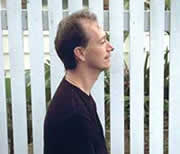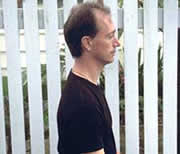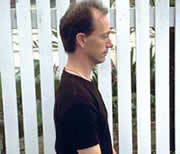Peter Grunwald answers the most commonly asked questions about his EyeBody Method.
The questions are grouped together under headings.
The Method
Generally speaking, this method can help anyone who would like to improve their eyesight, vision or posture. If you are short-sighted (myopic), you can learn how to gradually undo the habits associated with short-sightedness. If you are long-sighted (presbyopic), you can undo the habits relating to this middle-age sight problem. Also if you have back, neck or shoulder tension, or any other forms of physical discomfort, this method could help you.
This Method helps to improve naturally on eyesight, vision and posture. I have discovered that there are direct links between areas of the eyes and the physical body. By learning how to ‘direct’ our visual system, the body simultaneously follows, releasing patterns of tension. This method can be applied to reduce and eliminate the need for wearing glasses/contact lenses, improve on visual malfunctions and simultaneously improve posture and internal body function.
Like a chicken and egg question, the two are interrelated. My experience tells me that vision problems are usually established first, very subtly without our realizing. But it is likely to be a physical discomfort in the body or a visual blurring we notice first, sometimes years after the initial vision problem begins. The pattern always seems to be found both within the visual system and the physical.
Principles are mental attitudes, which can be applied regardless of the activity or situation. Exercises are activities often associated with some form of ‘doing’, or physical action. The Method uses visual principles, which allow the overall brain, eye and body to function more easily as a coordinated unity. These principles can then be applied to any activities, such as reading the newspaper, driving a car, early morning jogging – and to ‘eye exercises’ themselves.
Different conditions of eye and vision
Generally speaking, yes. As this method is fundamentally based upon visual principles, the freeing of specific conditions comes from gradually working with the entire visual system. Specific visual and bodily conditions will, over time, change and begin to function naturally and optimally.
Yes. These are very common visual malfunctions. By learning how to release tension within the visual system generally and then specifically, the physiology of each condition changes.
The core areas of the body likely to be affected are:
- Short-sightedness (myopia): affects the lower back and pelvic area, the upper legs to the knees. It can also cause neck and shoulder tension, with a general postural slump.
- Middle-age vision (presbyopia): also affects the lower back and pelvis and especially the upper back, chest area and the breathing mechanism.
- Far-sightedness (hypermetropia): affects the upper area of the body, especially the heart and lung region. An emotional response can be a short temper and impatience with oneself and others. Posture is very upright.
- Astigmatism: affects the shoulder girdle and neck region with a slumping of the shoulders
In all three conditions the overall activity of the visual brain needs to be increased first, then:
- in case of glaucoma it is necessary to release the shortening in the areas of the front of the eyes (especially the Canal of Schlemm);
- in the case of cataracts, to bring nutrition into the fluid of the lens so that it can decalcify and the capsule of the lens can function optimally;
- with macular degeneration, applying the principles helps the retina, the vitreous humor and the choroid behind the retina to function better. Even if you have had an operation to correct one of these conditions, the habits, which set up the problem in the first place, can be modified using the Method.
The core areas of the rest of the body likely to be affected are:
- Glaucoma: a tightening of the upper chest affecting the lymphatic system and the heart area, also there is an affect on the pelvis/hip area and the femur bone connection.
- Cataracts: affects the diaphragm and the breathing with very often a marked curvature of the upper back and shoulders.
- Macular Degeneration: affects are shown in the pelvic area, lower back and visceral organs.
Here it depends on the connections of the optic nerves to the brainstem, which have been disrupted. This can be rectified so that both visual pathways function together. Crossed eyes manifest in the body by the affected side of the upper leg turning either in or out, affecting the legs and knees and pelvic connection.
Seeing this from a body and postural viewpoint, the eyes and their pathways which connect to the brain show us a map of postural/body problems. The Method will address these problems first indirectly, by applying general principles and then directly, through the better functioning of the visual system with simultaneous effects on the rest of the body.
1. Postural alignment and vision:
Posture is directly affected by seeing. In all conditions (except far-sightedness from an early age) the optic nerve will follow a downwards path to the brainstem. This will always tilt the brainstem slightly back and down, shortening the spinal cord – with a slumped posture because the spine is not optimally supporting the weight of the body.
The following pictures were taken with Matthias Erdrich directing only his visual system and allowing his body to follow:



2. Back, neck, shoulder pains: These are related to eyeball malfunction, especially short-sightedness and presbyopia, as well as astigmatism.
3. Breathing and respiratory disorders: These are found within the area of the cillary body and lens. This is almost like the dividing area between the front and the back of the eye and in many different visual malfunctions, especially presbyopia, during the formation of cataracts, or even after a cataract operation – the respiratory system is affected. The upper back and thoracic area are also usually involved.
4. Headaches, nose, ear and throat problems: Headaches have various causes. Often they are a result of over-focusing and straining the visual system and the retina in relationship to the lower back and the pituitary gland, which regulates hormonal cycles and the growth process.
5. The nose, ear and throat are very closely associated with the axillary or front area of the eyes, namely the eyelids and the conjunctiva. By applying the Method these will be in better working condition. In response, the bone structure of the nose and frontal area of the face will change, the inner ear canal will widen and the neck/throat area become freer, lengthening and widening in the process.
6. Many conditions related to a weakened immune system can also benefit. As the overall visual system strengthens, so does the body. Vision leads, eyes and body follow.
Wearing glasses and contact lenses
Yes, in most cases this is absolutely possible. Depending on your commitment and how conscientiously you apply the Method, you can achieve this in a relatively short time.
You will have to let go of the habit of wearing glasses and strengthen the visual system so that you will not need glasses any more. But first you will have to learn about your habit before you can let it go.
I often suggest first using reduced strength lenses so that the transition is easier. The whole time you are learning the Method, your visual system will be improving, and the need for glasses or contacts will be diminishing.
This depends on the malfunction, your emotional constitution, and your ability to apply the principles in activities like driving and reading. If you take it step by step, the process can be great fun and enjoyable. For some people it may take a few days, for others, several months or even years.
Operations / laser surgery
If an operation was performed, let’s say for crossed eyes in childhood, cataracts or retinal detachment, you can learn to use your visual system better (often below the level where you notice it) and prevent further deterioration. In general, if an operation was needed, it is likely the whole visual system was compromised.
Laser surgery is performed on the cornea so that the light will fall directly onto the fovea centralis, with resulting clear-sightedness. But the condition of short-sightedness (the elongated eyeball), the thinking and use of the brain, still remain ‘short-sighted’.
Although you might not wear glasses any longer and be satisfied, you can benefit from using this method to learn how to use the whole visual system fully and satisfactorily.
Often the operation was not completely satisfactory. If you still need glasses (perhaps 20/20 was not achieved), or some other malfunction, like lack of clarity while reading close up or increased sensitivity especially at night has developed, engaging in this method will help you learn how to handle your condition naturally and safely from within.
Prior requirements
Yes. Sometimes posture seems to improve more rapidly, with vision following gradually, because we are more accustomed to observing the body than the subtleties of our vision (other than clear-sightedness).
There are few basic requirements. It’s good to keep an open mind when learning something new. A ‘constructive scepticism’ can be helpful, a ‘destructive scepticism’ will not allow you to learn; it will limit you to what you already know. A certain level of commitment and willingness to change is fundamental.
Age and time
The learning process is not dependent on age.
Certainly. I have had people in my workshops in their 90’s who did very well. Age is not a limitation, even if the body may change at a slower pace. Change is possible at any age. I notice that age can even be a big advantage, as life experience helps to make one more observant, and often more thoughtful and aware.
That depends on different factors. The ability to learn kinesthetically as well as conceptually, certain openness and readiness, changing your attentiveness in daily activities, and the steady application of the principles in daily activities all play apart in how quickly you learn.
Pre-birth and early childhood conditions
Yes they can. We do not stop growing and changing because we are no longer in the womb.
Other side benefits or improvements
Emotions like anxiety, fear or anger play a large role in the vision process. By releasing the vitreous humor, the ‘jelly like’ fluid within the eyeball, emotions are eased and the lower back and visceral organs will gradually function normally. The vitreous humor fluid will help to support the eyeball again from within.
Participants always comment on many other benefits, like increased lightness in their body, less anxiety, especially in short-sightedness, less pain in menstrual cycles and increased attention and mental clarity.
And because overall brain activity increases, this stimulates brain, eye and body function and therefore the overall health of a person is improved.
How to learn this Method
Self help is always to be encouraged. However, when we work with life-long habits it is highly recommended that you be guided by a skilled teacher who has ‘been there before’. Together you can ‘discover’ new ways to think and respond and thereby recognize old habits so you can freely choose what is more appropriate in a given situation.
The first step of guidance is often participating in a retreat workshop. These are run annually in different parts of the world. Group and individual attention is given to learn and understand the principles and to assimilate them gradually. Sharing in the experiences of others helps you learn about yourself.
Individual lessons are highly recommended but are only offered in certain locations when a teacher is available. The combination of individual lessons and workshop attendance is the best way to assimilate and to learn.
Pinhole Glasses
Pinhole Glasses are an excellent tool for seeing clearly and to exercising the retina. They stimulate the entire retina; the panoramic as well as the macular area of the eye. Start using them for watching TV, going to the movies, or reading a book or newspaper. They help especially in cases of short-sightedness, far-sightedness, astigmatism and middle-age sight.
Apply the EyeBody Method daily
Right now in your daily life, in activites such as reading the paper or working at the computer, driving a car or washing dishes. It will become fun to observe yourself and function with more ease and clarity.
Yes. If you are a musician you will gradually be able to apply this in your ability to read sheet music. You may notice changes in the quality of playing your instrument or using your already-trained voice.
If you use a computer you will notice a change the way you use your brain, eyes and body to do so.
In sports or gym workouts you will see an increase in your potential as you use the visual process to enhance what you have already achieved.



